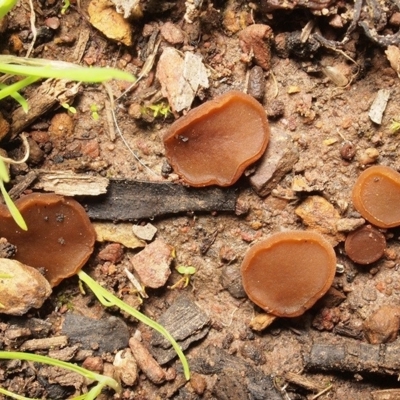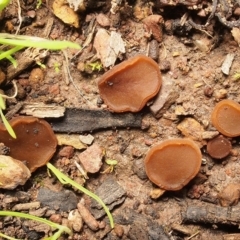Aleurina asperula
The fruitbody may be disk-like (and then with a raised rim) or resemble a shallow cup. There is no stem and the disk/cup may be up to 15 millimetres in diameter. The fruitbody has a rubbery texture and is brown, with the lower surface often a little paler than the upper surface. The upper surface is smooth and the lower surface has tiny pustules or warts (at least near the margin).
The fruitbodies appear on soil.
Look-alikes
Three other Aleurina species have been found in Australia: Aleurina argentina, Aleurina ferruginea (both occur in the ACT) and Aleurina calospora. The fruitbodies are up to 2 centimetres in diameter, in shades of brown, with warty margins and are mostly found on soil (though argentina and ferruginea have been found on decayed wood). Aleurina species are best identified by microscopic features (see the references) but a more yellowish to olive-greenish fruitbody suggests Aleurina ferruginea, while a very dark fruitbody suggests Aleurina argentina or Aleurina calospora (and the one herbarium specimen of the former, collected in the botanic gardens in 2005, includes this comment about the upper surface "olive-brown to blackish-brown or almost black"). However, each of those species may be found in a range of brown shades, so an Aleurina in between the yellow/olive and 'almost black' extremes gives you no quick suggestion of which species.
Various species of Peziza produce brown, cup-like fruitbodies on soil and in a few species you find warty lower surfaces. Pezizas are often more deeply cup-like and some have whitish lower surfaces.
Species of Plectania, Pseudoplectania and Urnula are blackish, may have warty outer surfaces but are usually deeply cup-like, are mostly found on wood and the cup often tapers downwards to yield a well-developed pseudo-stem.
References
Rifai, M.A. (1968). The Australasian Pezizales in the herbarium of the Royal Botanic Gardens Kew, Noord-Hollandsche U.M, Amsterdam.
Rifai uses the name Jafneadelphus instead of Aleurina.
Zhuang, W.-Y. & Korf, R.P. (1986). A monograph of the genus Aleurina Massee (=Jafneadelphus Rifai), Mycotaxon, 26, 361-400.
Aleurina asperula is listed in the following regions:
Canberra & Southern Tablelands
Species information
- Aleurina asperula Scientific name
- Common name
- Not Sensitive
- Local native
- Non-invasive or negligible
- Up to 647m Recorded at altitude
- Machine learning















